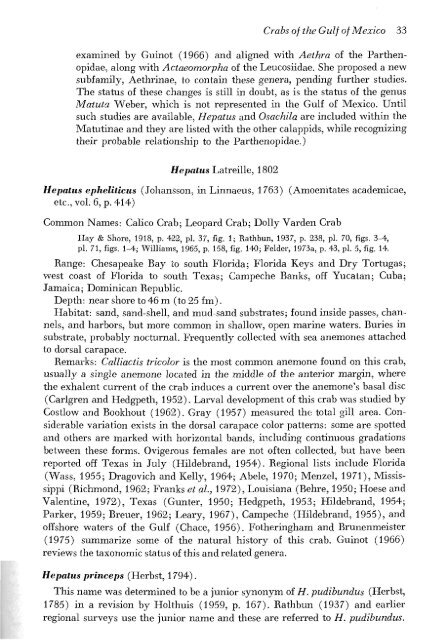You also want an ePaper? Increase the reach of your titles
YUMPU automatically turns print PDFs into web optimized ePapers that Google loves.
Crabs of the Gulf of Mexico 33<br />
examined by Guinot (1966) and aligned with Aethra of the Parthenopidae,<br />
along with Actaeomorpha of the Leucosiidae. She proposed a new<br />
subfamily, Aethrinae, to contain these genera, pending further studies.<br />
The status of these changes is still in doubt, as is the status of the genus<br />
Matuta Weber, which is not represented in the Gulf of Mexico. Until<br />
such studies are available, Hepatus and Osachila are included within the<br />
Matutinae and they are listed with the other calappids, while recognizing<br />
their probable relationship to the Parthenopidae.)<br />
Hepalus Latreille, 1802<br />
Hepalus ephelilicus (Johansson, in Linnaeus, 1763) (Amoemtates academicae,<br />
etc., vol. 6, p. 414)<br />
Common Names: Calico Crab; Leopard Crab; Dolly Varden Crab<br />
Hay & Shore, 1918, p. 422, pi. 37, fig. 1; Rathbun, 1937, p. 238, pi. 70, figs. 3-4,<br />
pi. 71, figs. 1-4; Williams, 196S, p. 158, fig. 140; Felder, 1973a, p. 43, pi. 5, fig. 14.<br />
Range: Chesapeake Bay to south Florida; Florida Keys and Dry Tortugas;<br />
west coast of Florida to south Texas; Campeche Banks, off Yucatan; Cuba;<br />
Jamaica; Dominican Republic.<br />
Depth: near shore to 46 m (to 25 fm).<br />
Habitat: sand, sand-shell, and mud-sand substrates; found inside passes, channels,<br />
and harbors, but more common in shallow, open marine waters. Buries in<br />
substrate, probablj^ nocturnal. Frequently collected with sea anemones attached<br />
to dorsal carapace.<br />
Remarks: Calliactis tricolor is the most common anemone found on this crab,<br />
usually a single anemone located in the middle of the anterior margin, where<br />
the exhalent current of the crab induces a current over the anemone's basal disc<br />
(Carlgren and Hedgpeth, 1952). Larval development of this crab was studied by<br />
Costlow and Bookhout (1962). Gvaj (1957) measured the total gill area. Considerable<br />
variation exists in the dorsal carapace color patterns: some are spotted<br />
and others are marked with horizontal bands, including continuous gradations<br />
between these forms. Ovigerous females are not often collected, but have been<br />
reported off Texas in July (Hildebrand, 1954). Regional lists include Florida<br />
(Wass, 1955; Dragovich and Kelly, 1964; Abele, 1970; Menzel, 1971), Mississippi<br />
(Richmond, 1962; Franks et ah, 1972), Louisiana (Behre, 1950; Hoese and<br />
Valentine, 1972), Texas (Gunter, 1950; Hedgpeth, 1953; Hildebrand, 1954;<br />
Parker, 1959; Breuer, 1962; Leary, 1967), Campeche (Hildebrand, 1955), and<br />
offshore waters of the Gulf (Chace, 1956). Fotheringham and Brunenmeister<br />
(1975) summarize some of the natural history of this crab. Guinot (1966)<br />
reviews the taxonomic status of this and related genera.<br />
Hepalus princeps (Herbst, 1794).<br />
This name was determined to be a junior synonym of H. pudibundus (Herbst,<br />
1785) in a revision by Holthuis (1959, p. 167). Rathbun (1937) and earlier<br />
regional surveys use the junior name and these are referred to H. pudibundus.

















